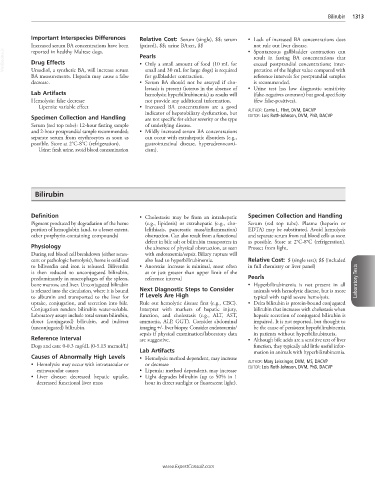Page 2595 - Cote clinical veterinary advisor dogs and cats 4th
P. 2595
Bilirubin 1313
Important Interspecies Differences Relative Cost: Serum (single), $$; serum • Lack of increased BA concentrations does
not rule out liver disease.
Increased serum BA concentrations have been (paired), $$; urine BA:crt, $$ • Spontaneous gallbladder contraction can
VetBooks.ir Drug Effects Pearls result in fasting BA concentrations that
reported in healthy Maltese dogs.
• Only a small amount of food (10 mL for
exceed postprandial concentrations; inter-
Ursodiol, a synthetic BA, will increase serum
BA measurements. Heparin may cause a false small and 30 mL for large dogs) is required pretation of the higher value compared with
for gallbladder contraction.
reference intervals for postprandial samples
decrease. • Serum BA should not be assayed if cho- is recommended.
lestasis is present (icterus in the absence of • Urine test has low diagnostic sensitivity
Lab Artifacts hemolysis; hyperbilirubinemia) as results will (false-negatives common) but good specificity
Hemolysis: false decrease not provide any additional information. (few false-positives).
Lipemia: variable effect • Increased BA concentrations are a good
indicator of hepatobiliary dysfunction, but AUTHOR: Carrie L. Flint, DVM, DACVP
Specimen Collection and Handling are not specific for either severity or the type EDITOR: Lois Roth-Johnson, DVM, PhD, DACVP
Serum (red top tube): 12-hour fasting sample of underlying disease.
and 2-hour postprandial sample recommended; • Mildly increased serum BA concentrations
separate serum from erythrocytes as soon as can occur with extrahepatic disorders (e.g.,
possible. Store at 2°C-8°C (refrigeration). gastrointestinal disease, hyperadrenocorti-
Urine: fresh urine, avoid blood contamination cism).
Bilirubin
Definition • Cholestasis: may be from an intrahepatic Specimen Collection and Handling
Pigment produced by degradation of the heme (e.g., lipidosis) or extrahepatic (e.g., cho- Serum (red top tube). Plasma (heparin or
portion of hemoglobin (and, to a lesser extent, lelithiasis, pancreatic mass/inflammation) EDTA) may be substituted. Avoid hemolysis
other porphyrin-containing compounds) obstruction. Can also result from a functional and separate serum from red blood cells as soon
defect in bile salt or bilirubin transporters in as possible. Store at 2°C-8°C (refrigeration).
Physiology the absence of physical obstruction, as seen Protect from light.
During red blood cell breakdown (either senes- with endotoxemia/sepsis. Biliary rupture will
cent or pathologic hemolysis), heme is oxidized also lead to hyperbilirubinemia. Relative Cost: $ (single test); $$ (included
to biliverdin and iron is released. Biliverdin • Anorexia: increase is minimal, most often in full chemistry or liver panel)
is then reduced to unconjugated bilirubin, at or just greater than upper limit of the
predominantly in macrophages of the spleen, reference interval Pearls Laboratory Tests
bone marrow, and liver. Unconjugated bilirubin • Hyperbilirubinemia is not present in all
is released into the circulation, where it is bound Next Diagnostic Steps to Consider animals with hemolytic disease, but is more
to albumin and transported to the liver for if Levels Are High typical with rapid severe hemolysis.
uptake, conjugation, and secretion into bile. Rule out hemolytic disease first (e.g., CBC). • Delta bilirubin is protein-bound conjugated
Conjugation renders bilirubin water-soluble. Interpret with markers of hepatic injury, bilirubin that increases with cholestasis when
Laboratory assays include total serum bilirubin, function, and cholestasis (e.g., ALT, AST, hepatic secretion of conjugated bilirubin is
direct (conjugated) bilirubin, and indirect ammonia, ALP, GGT). Consider abdominal impaired. It is not reported, but thought to
(unconjugated) bilirubin. imaging +/- liver biopsy. Consider endotoxemia/ be the cause of persistent hyperbilirubinemia
sepsis if physical examination/laboratory data in patients without hyperbilirubinuria.
Reference Interval are suggestive. • Although bile acids are a sensitive test of liver
Dogs and cats: 0-0.3 mg/dL (0-5.13 mcmol/L) function, they typically add little useful infor-
Lab Artifacts mation in animals with hyperbilirubinemia.
Causes of Abnormally High Levels • Hemolysis: method dependent, may increase
• Hemolysis: may occur with intravascular or or decrease AUTHOR: Mary Leissinger, DVM, MS, DACVP
EDITOR: Lois Roth-Johnson, DVM, PhD, DACVP
extravascular causes • Lipemia: method dependent, may increase
• Liver disease: decreased hepatic uptake, • Light degrades bilirubin (up to 50% in 1
decreased functional liver mass hour in direct sunlight or fluorescent light).
www.ExpertConsult.com

